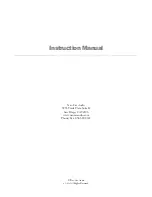
English
60
Pompes Salmson 05/2015
NOTE: "Q-Limit" can only be set using the IR operating and service unit (accessory).
If "Q-Limit" is used in non-hydraulically balanced systems, partial areas can be
undersupplied. Perform hydraulic balancing.
6.2.4 General functions of the pump
• The pump is equipped with an electronic
overload protection
function which
switches off the pump in the event of an overload.
• For
data storage
, the control module is equipped with a non-fading memory. All
settings and data are retained no matter how longer the module is disconnected
from the power supply. When the power supply is re-established, the pump con-
tinues to run with the values set prior to disconnection from the power supply.
•
Pump kick:
Any pumps switched off via the (ON/OFF) menu, a bus command,
the infrared interface, the Ext.Off control input or 0-10V start running for a
short time every 24 hours to prevent blockages in the event of long standstill
periods. The mains voltage must not be interrupted for this function.If discon-
nection from the mains is planned for a lengthy period, the pump kick must be
applied by the heating/boiler control by switching on the mains voltage briefly.
For this, the pump must be switched on by the control prior to disconnection
from the mains (display
→
motor/module symbol lights up).
•
SSM:
The contact of the collective fault signal (potential-free normally closed
contact) can be connected to a building automation system. The internal con-
tact is closed if the pump is without power, if there is no fault or if there is a mal-
function of the control module. The performance of the SSM is described in
Chapters 6.2.5, 10.1 and 10.2.
• For connecting to external monitoring units, the system can be expanded by
retrofitting interface modules for communication. Analogue and digital IF Mod-
ules are available as an option (see catalogue).
6.2.5 Dual pump operation
Double pumps or two single pumps (installed in parallel) can be retrofitted with
an integrated dual pump management system.
•
IF-Modules Siriux:
For communication between pumps, an IF Module is
installed in the control module of each pump. These IF Modules are connected
to each other via the DP interface.
This dual pump management has the following functions:
•
Master/slave:
Both pumps are controlled by the master. All setting are made at
the master.
•
Main/standby mode:
Each of the two pumps provides the configured flow rate.
The other pump is available in case of a malfunction or runs after pump cycling.
Always only one pump runs. Main/standby mode is also fully active with two sin-
gle pumps of the same type in one double pump installation.
•
Efficiency-optimised peak-load operation:
In the partial load range, the
hydraulic output is provided at the beginning by one pump. The second pump is
then also connected for efficiency optimisation if the total power consumption
P
1
of both pumps is less than the power consumption P
1
of one pump. Both
pumps are then simultaneously adjusted upwards to the maximum speed. This
















































